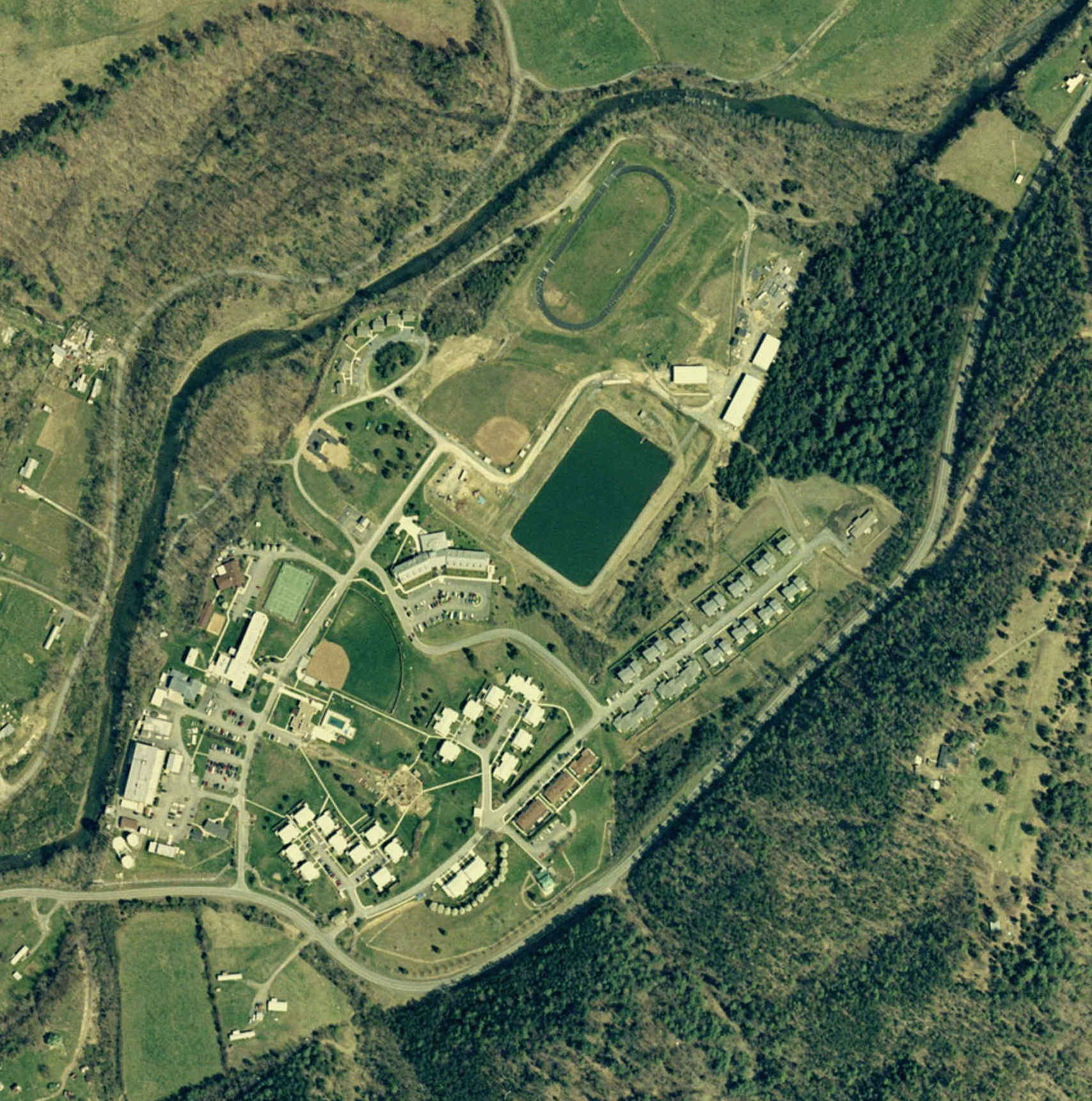
27 August 2010. Add Google Earth photos.
23 December 2005. Add 2001 photo of antennas, map and aerial photographs
of Sugar Grove Base support facility of the antenna farm.
|
|
22 December 2005. Revise URL for MrSID image:
ftp://ftp.wvgis.wvu.edu/pub/Clearinghouse/SAMB03/UTM83/utm83zone17n/QQuad_mrsids/sugar_grove_se.sid
(19MB)
26 October 2005. A. writes:
Some notes on Sugar Grove:
Following the disestablishment of the Naval Security Group and realignment
of its personnel and assets under Naval Network Warfare Command (as
noted earlier on your webpage), NSGA Sugar Grove was renamed Navy Information
Operations Command (NIOC) Sugar Grove.
The two Wullenweber antennas (variants of the FRD-10), which were built in
1969, have both been dismantled, as the 2005 satellite photo recently added
shows. The more northern one had already been dismantled by the time of the
1997 satellite photo. Unlike the other FRD-10s, which were operated by the
Naval Security Group for high-frequency direction-finding and SIGINT collection,
the arrays at Sugar Grove were used for ship-shore communications by the
U.S. Navy.
The story of the 600-foot dish, intended at the time to be the "world's biggest
bug", is told in James Bamford's first book about the NSA, The Puzzle Palace.
More information on the history of the Sugar Grove station, the Wullenwebers,
and the big dish is at these sites:
http://coldwar-c4i.net/Sugar_Grove/history.html
http://groups.yahoo.com/group/coldwarcomms/message/9260
23 October 2005. Updated to add August 2005 aerial photos excerpted and converted
to JPG from MrSID:
ftp://ftp.wvgis.wvu.edu/pub/Clearinghouse/SAMB03/UTM83/utm83zone17n/sugar_grove_se.sid
[Superceding URL above.]
8 October 2005. Updated to add the following two West Virginia GIS satellite
photos. See related news release
of the disbanding of the Naval Security Group Command to become part of the
Naval Network Warfare Command:
http://cryptome.org/echelon-reorg.htm
From the Coldwarcomms Mail List:
6 October 2005
I found the following in a declassified National Security Council document
dated June 30, 1958, in the event it interests anyone:
"Naval Radio Research Observatory (NRRO). This observatory is to be erected
at Sugar Grove, West Virginia for exploiting lunar reflective techniques for
the purposes of intelligence collection, radio astronomy, and
communications-electronics research. A 600-foot steerable parabolic radio
antenna will provide for the reception of electromagnetic emissions reflected
off the moon. As an intelligence device it will provide for reception and
analyzing emissions from areas of the world not now accessible by any other
known method, short of physical penetration. The Observatory is planned to
be operational in FY 1962." [there then follows discussion of the required
construction budget]
One of the two Wallenweber antennas (the large circular layouts) appear to
be inactive, with several
antennas installed instead. The other Wallenweber remains in this photo but
it is not clear if it
is active. Wallenweber's were signal direction finding devices, with dozens
of pole-receivers located
on the circumference, each picking up a signal from a slightly different
angle. The combined receptions
were triangulated to establish the direction of the signal source.

Note the large antenna at the upper right of the photo below. This may a
smaller descendent of the giant
600-foot diameter "moon-bounce" antenna.

28 April 2002
Source: Mapquest.com
See:
http://www.iptvreports.mcmail.com/ic2kreport.htm
Interception Capabilities 2000
By Duncan Campbell
Sugar Grove, Virginia - COMSAT interception at ECHELON site
73. US government documents confirm that the satellite
receiving station at Sugar Grove, West Virginia is an ECHELON site, and that
collects intelligence from COMSATs. The station is about 250 miles south-west
of Washington, in a remote area of the Shenandoah Mountains. It is operated
by the US Naval Security Group and the US Air Force Intelligence Agency.
74. An upgraded system called TIMBERLINE II, was installed at Sugar Grove
in the summer of 1990. At the same time, according to official US documents,
an "ECHELON training department" was established.(47) With training complete,
the task of the station in 1991 became "to maintain and operate an ECHELON
site".(48)
75. The US Air Force has publicly identified the intelligence activity at
Sugar Grove: its "mission is to direct satellite communications equipment
[in support of] consumers of COMSAT information ... This is achieved by providing
a trained cadre of collection system operators, analysts and managers".(49)
In 1990, satellite photographs showed that there were 4 satellite antennae
at Sugar Grove. By November 1998, ground inspection revealed that this had
expanded to a group of 9.
Eyeballing
Sugar
Grove
Echelon
Station
|
 |
 |
 |
 |
 |
 |
 |
 |
 |
 |
 |
 |
 |
 |
 |
 |
 |
 |
 |
 |
 |
 |

Antennas are located in circle shown at left.
ZD
Net Photo |
 |
 |
|
|

![[Image]](pict0.jpg)
![[Image]](pict1.jpg)
![[Image]](pict2.jpg)
![[Image]](pict3.jpg)
![[Image]](sugar-2001.jpg)




































